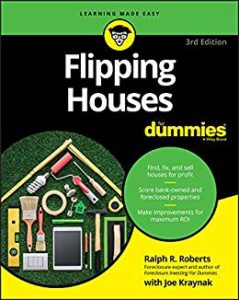House flipping has seen many booms and busts in popularity over the years but the fundamentals of flipping have changed very little over time.
While right now there is a resurgence in house flipping popularity the truth of the matter is, by using sound principles you can successfully start flipping houses regardless of its current popularity.
For beginner house flippers though, one of the hardest parts is trying to figure out how to get started and the first steps to take.
The good news though is that once you’ve learned the process and steps involved in flipping, you can use that process as a repeatable system that will allow you to flip as many houses as you like.
Before we go any further though it’s important to define what we mean when we say flipping houses, as there are many different ways to “flip a house”.
Flipping Houses Definition
For the purposes of this guide when we say flipping houses we are referring to the below definition of house flipping.
Flipping houses means to resell a home quickly for profit by updating and remodeling the home.
Flipping Houses System
While there are no guarantees when it comes to house flipping, by using a repeatable process and system you can greatly reduce the risks associated with house flipping.
While there are many different ways to flip a house, this is the system and process I used when first starting out and is the same system I use today which has allowed me successfully flip multiple properties.
Step 1 – House Flipping and Market Knowledge
It’s important when figuring out how to start flipping houses to develop a strong foundation of knowledge about house flipping and your local real estate market. This early research will be invaluable to your house flipping business as it will help guide your house flipping decisions and help you avoid mistakes and pitfalls along the way.
House Flipping Knowledge
This guide is a great starting point to your house flipping foundation but remember house flipping is far too broad of a topic to adequately cover in a starter guide on how to start flipping houses.
As the old saying goes “knowledge is power”.
Before I started flipping houses I read a ton of books on the topic and watched numerous videos to learn everything I could about flipping houses. This one practice made all the difference in the world for me especially when first starting out because the more information I learned about house flipping the more confidence I gained in my abilities to successfully flip a house.
I read everything about house flipping I could get my hands on but a few books that really stood out and that provided a ton of useful information about house flipping include:
The Book on Flipping Houses: How to Buy, Rehab, and Resell Residential Properties
Flip: How to Find, Fix, and Sell Houses for Profit
As you are already probably aware, Youtube offers a ton of great information on a variety of topics and house flipping is no exception.
As a word of caution though when on Youtube make sure to avoid all the get quick rich schemes and house flipping gurus selling products.
Remember house flipping is built on sound principles and hard work and there are no shortcuts when it comes to house flipping.
Below are two of my favorite house flippers on Youtube that provide quality and sound information about house flipping and real estate when first getting started.
Great All-Around Information on House Flipping and Real Estate
Focusses Mainly on Rental Property But Still a Ton of Great Information about Real Estate and the Rehab Process
Real Estate Market Knowledge
When building foundational knowledge on how to start flipping houses the other critical piece of the puzzle is to have in-depth local real estate knowledge.
To be a successful house flipper, you must have a thorough understanding of the real estate market you’ll be working in.
As this information is crucial in order to identify potential deals and to know how much a home can be sold for once the rehab is complete.
When first starting out I had a leg up in this department as I was a real estate agent before becoming a house flipper. So when starting out as a house flipper thanks to my work as a real estate agent I already had a thorough understanding of the market.
Don’t worry though while it can be helpful, the good news is you don’t have to be a real estate agent to be a successful house flipper. But to be a successful house flipper you do need to know the same information that a real estate agent would know about the local real estate market.
When doing your due diligence and performing your market research good things to know include average sales prices, average days on market or DOM, current home inventory levels, and what buyers are looking for in your area.
Step 2 – Finding the Property
Finding the right house to flip can be one of the most challenging steps of house flipping.
When trying to find a property to buy and flip it can often feel like you are trying to find a needle in a haystack because, in essence, you are.
When looking for property it truly is a numbers game, because the more houses you look at the better your chances are of finding a great property to flip.
While there is no specific number of properties you need to look at to find the right one, you must be prepared to look at as many as it takes to get the job done.
Speaking from my own experience I usually have to look at at least 10 to 15 properties before finding a property that makes sense and sometimes it can be even more depending on the current real estate market.
The important thing is to not get discouraged and to keep turning over those rocks until you find that one right property.
Things to Consider When Looking for Properties to Flip
When looking at properties there are a few key concepts you can use to help evaluate the property and let you know when you’ve potentially found the right one to flip.
- 70% Rule – When evaluating a potential property flip a great ratio to keep in mind is the 70% rule. In essence, the 70% rule tells the flipper the maximum amount they can pay for a property and still make a good profit. With the 70% rule you first must know the ARV or after repaired value of the property then you multiply that number by 0.7. You then take that number and minus the anticipated repair costs for the property to arrive at the maximum amount you can pay for the property. So for example, if the ARV is $100,000 you would multiply this by 0.7 which would give you $70,000. Then let’s say the repair cost on the home where $15,000 so you would then take $70,000 – $15,000. Which would mean the most you could pay for the property would be $55,000. By using this formula you can, in essence, carve out a potential 30% profit margin for yourself on the house flip.
- Know Your Limitations – When looking at properties it’s important to account for your skill level when it comes to repairing and remodeling a home. Often times when house flippers are first starting out, they can quickly get in over the heads when it comes to home repairs and remodeling. As a new house flipper its best to stay on the lighter side of home repair and remodeling in order to avoid getting in over your head and potentially losing money.
- Have Multiple Sources for Property – Never limit yourself to just one source for properties when looking for a house to flip. Always have multiple avenues for property that you can pull from to increase your chances of finding a property. Some great places to find a distressed property to flip include the MLS, REO’s, auctions, estate sales, direct mail, sheriff sales and friends and family.

Step 3 – Financing the Deal
While financing the deal is the third step in the house flipping process it’s important not to wait until you find a property before you start to think about how to finance the flip.
Time is of the essence when it comes to flipping houses because when there’s a good deal on a property it won’t last long. When flipping houses you have to be ready to snatch a property up within days if not hours so someone else doesn’t grab it.
So, long before you find that perfect house to flip it’s important to get your finances in order to not only purchase the home but also to perform the needed repairs. So when that great deal comes along you’ll be ready.
Also, remember when house flipping you will usually be dealing with distressed property with many property condition issues that will prevent standard home financings such as a conventional 30 or 15-year mortgage. Because of these property condition issues, you will typically be using alternative forms of financing when it comes to buying a house flip.
There are far too many ways to finance a real estate flip to go into great detail here but a few of the more popular ways to finance a real estate flip include partnering, hard money loans, or cash.
For more detailed information on how to finance a flip check out our article on “How to Get Money to Flip a House“.
Step 4 – Rehabbing the Flip
The one-step that is consistently underestimated when it comes to money and time is the rehab of the property.
Remember a universal rule when rehabbing a property is that it always takes more money and time than you think it’s going to.
To help minimize these underestimations, it’s important to lay as much groundwork as possible before the first hammer is swung, to prevent unnecessary mistakes or cost overruns during the remodel.
One of the most important pieces of that groundwork includes creating a detailed budget and plan that covers not only what repairs are going to be completed but also the amount of time each repair will take as well as the anticipated cost for each of those repairs.
While it’s impossible to create a perfect budget and plan it’s still important to have one as it will help you stay on track and on budget throughout the rehab process of the home.
Another thing to consider when it comes to the rehab of the flip is who will be performing the work on the home.
Will you mainly be using contractors and subcontractors to complete the work, or will you be doing most of the work yourself? While there is no right or wrong answer to this question it’s important to accommodate for this in time and money on your budget.
Speaking as someone who flips houses in the midwest, while we usually use a few subcontractors to complete some of the more technical work such as electrical, HVAC, or roofing, we typically do as much as 80 to 90% of the work on the house to save money and protect the profits of the flip.
While we would prefer to farm more of the workout, due to the high cost of labor it has always been to cost-prohibitive to do so.

Step 5 – Selling the Flip
When the rehab of the property is complete you might think the work is over. However, there is one final and very important step still left which is selling the flip.
It’s important to remember that this final step can make or break all the work leading up to this point.
Because if you can’t sell the home for a profit then all the work you completed prior to the sale of the home was for nothing.
When first starting out as a new house flipper don’t make the mistake of just sticking a for sale sign in the front yard and hoping for the best.
Just like you needed a plan to rehab the property, you also need a plan to sell the property.
Below is the typical marketing plan we use to sell one of our flips for top dollar.
- Finish the Flip Before You Market the Home – While flippers have many different opinions on this we do not list the home for sale or show the property until the home is completely finished. While you might have a vision for how the home will look when it’s done most buyers will not have that same vision and showing the home to buyers before it’s finished is a good way to lose a lot of potential buyers for the home.
- Perform a Deep Clean – Remodeling and rehabbing a home is a messy business and can often leave layers of dust and dirt inside and outside the home. So before we list any of our flips for sale we always clean the house top to bottom.
- Take Great Photos – Taking great photos is one of the most important items of the marketing process. Make sure you have good lighting and use a nice camera to get the best possible photos of the house you can. Remember buyers look for homes online and the photos of the property will often provide their first impression of the home and determine if they have continued interest in the home to schedule a showing.
- List the Flip on the MLS – While I might be a little biased since I am a real estate agent myself, using a real estate agent and gaining the market exposure the MLS offers is invaluable in getting the flip sold quickly and for top dollar. While you can certainly sell a property on your own without an agent or the MLS and save some money on real estate commissions, it will often take you longer to sell the home and the offers you receive will usually be lower.
- Actively Market the Home – Once the home is listed we like to do as much marketing as possible to increase the chances of a quick sale which includes fliers, directional signs, and open houses.
- Stay on Top of the Sale – Sometimes the sale of a flip can take longer than expected and even when the home is sold you still have to go through the escrow process which can take a month or more. So it’s important to stay vigilant and not become complacent in the sale of the home until the property is sold and you have your proceeds check in hand.
How to Start Flipping Houses Conclusion
Hopefully, this how-to start flipping houses guide provided a ton of useful information to help you get started on your house flipping journey.
Remember though flipping houses is a journey and not a destination. When it comes to flipping houses especially when first starting out it’s important to keep moving forward, as the only time you truly fail as a house flipper is the moment you stop trying and give up.
Want to learn even more about the ins and outs of house flipping? Check out our article “How to Flip a House the Complete Guide“.
Recent Posts
How much does a push lawn mower cost? This is a question that many people have when they're looking for a new lawn mower. The good news, however, is that push lawn mowers are one of the most...
Are you looking for a cheap lawn mower? If so, you've come to the right place! Because in this blog post, we've highlighted the 10 cheapest lawn mowers on the market today. Plus, we provide...




